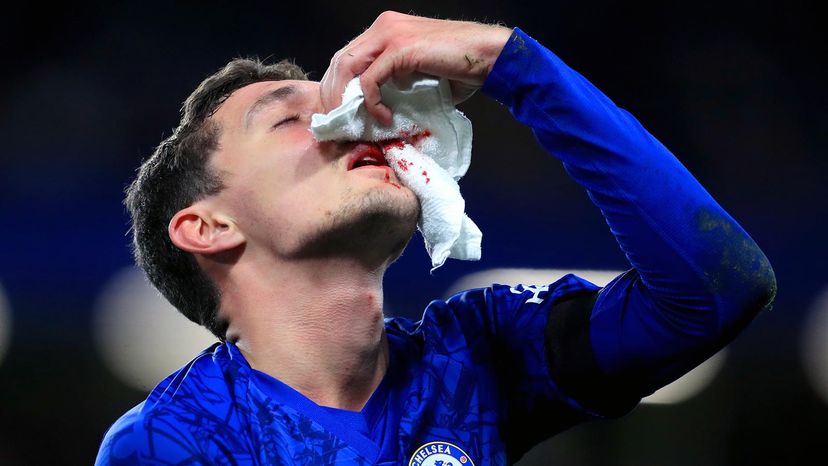 “Chelsea’s Andreas Christensen tilts his head back to stop a nosebleed after an injury during a match at Stamford Bridge, London. Is that the best way to stop one? Probably not. Mike Egerton – PA Images/PA Images via Getty Images
“Chelsea’s Andreas Christensen tilts his head back to stop a nosebleed after an injury during a match at Stamford Bridge, London. Is that the best way to stop one? Probably not. Mike Egerton – PA Images/PA Images via Getty Images
Nosebleeds may be annoying — and even startling — but they’re not uncommon. Each year, up to 60 million people in the U.S. experience a bloody nose, according to Yale Medicine. Known in the medical world as epistaxis, they’re most common among kids 2 to 10 years of age, and in adults 50 to 80.
The nose contains many blood vessels that help warm and humidify the air you inhale. They lie close to surface of the inside of your nose, which makes them prone to injury either from dry environments, blowing your nose too hard or picking at them with your fingers. Bleeds from this area of the nose are known as anterior nosebleeds.
Less common are posterior nosebleeds, which originate from branches of arteries inside the nasal cavity. These can be more serious, heavier and may require medical attention. Posterior nosebleeds can be caused a number of things:
- injury
- broken nose
- recent nasal surgery
- medications that thin the blood
- tumors in the nasal cavity
- blood clotting abnormalities
- hereditary conditions that affect the blood vessels
- leukemia
When the nose bleeds, blood can flow out of both nostrils, but it usually flows out of just one. In most cases, nosebleeds aren’t cause for alarm and can be effectively treated at home.
How Do You Stop a Nosebleed?
There are several ways to stop a bloody nose, but Yale Medicine suggests the following steps to stop it at home:
- Sit down and firmly pinch the soft part of your nose just above the nostrils for about 10 minutes using a tissue or towel.
- Don’t tilt you head back. Instead lean forward and breathe through your mouth. This will force blood toward the tissue on your nose and help prevent blood from rolling down the back of your throat and into your stomach.
- Place a cloth-covered ice pack on the bridge of your nose to tighten blood vessels and help relieve any inflammation.
- Don’t lie down. Keeping your nose above your heart will help reduce blood pressure in the blood vessels in your nose and lessen the bleed.
- If bleeding doesn’t stop after 10 minutes of pressure, use decongestant nose drops such as Afrin — two sprays in each nostril every 10 minutes up to three times until bleeding stops.
When to Seek Medical Attention
Heavy nosebleeds and those that don’t seem to stop can be worrisome. But how do you know if your nosebleed requires medical attention? According to RevereHealth, you may need to head to an urgent care clinic if you experience one or more of the following:
- The bleeding doesn’t stop after you apply pressure and/or usedecongestant nose drops.
- The bleeding is caused by a broken nose or minor trauma to the face.
- Your nose bleeds while you’re taking blood thinners.
Go to an emergency department if your nosebleed causes, or is accompanied by, any of the following symptoms:
- feeling faint, dizzy or lightheaded
- severe trauma, such as a car accident
- chest pain or tightness
- disorientation or confusion
- vomiting blood
- rash or fever
If your nosebleed persists, your doctor may pack your nose with special gauze or an inflatable latex balloon to apply constant pressure to the blood vessel. Or, they may cauterize the ruptured blood vessel using silver nitrate or an electrical heating device.
How Do You Prevent Nosebleeds?
Nosebleeds are usually sudden and unpredictable. But you can reduce your risk of getting them by taking a few preventative measures:
- Keep your nasal membranes moist, especially in colder, dryer months, by applying a light coat of petroleum jelly in each nostril, or using a saline nasal spray.
- Don’t pick your nose or, if you must, keep your fingernails trimmed to prevent injury.
- Use a humidifier to add moisture to the air of your home.
Now That’s Disgusting
Strongman Eddie "The Beast" Hall suffered a spontaneous nosebleed while deadlifting a record-breaking 1,100 pounds (500 kilograms) during the World Deadlift Championship in 2016. Hall said the lift nearly killed him, and he was right. Not only did he pass out immediately afterward, the maneuver caused him to burst several blood vessels in his head.














































